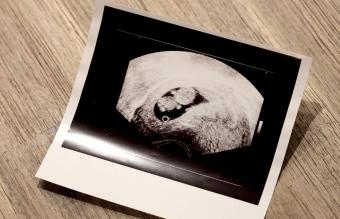
Having a baby is an exciting time and keeping track of your pregnancy size by week can help determine proper development of the fetus and assure that your pregnancy is going normally. Pregnancy lasts 40 weeks and a lot happens during this time to change the size of your abdomen as the fetus grows. Watching your pregnant belly grow and understanding how the baby develops each week makes pregnancy a little less overwhelming.
Measuring the Abdomen to Determine Pregnancy Size by Week
At each of your doctor's appointments, your abdomen will be measured. You should grow at a fairly predictable rate; if your doctor notices any discrepancies he will do other tests to see if there are any problems to the developing fetus. While you are lying on your back, your doctor will palpitate your abdomen to locate the top of your uterus. The doctor takes a tape measure and places the end at the base of the uterus, or your pubic bone, and measures to the top of your uterus. He also measures from your belly button to the top of your uterus. These measurements are called fundal height.
Pregnancy Calendar
Your doctor will determine the beginning of your pregnancy by counting back to the start of the first day of your last menstrual period. By the time you definitely know you are pregnant, weeks one, two, three, and possibly up to week six have all gone by. Your doctor will confirm your pregnancy with a blood test.
Weeks One and Two
These first few weeks of pregnancy are an important time for you to take care of your body because a lot happens with the baby's development. During weeks one and two, conception has not yet taken place, but your body is preparing for ovulation. The lining of the uterus is thickening and preparing to implant a fertilized egg. Begin taking prenatal vitamins, which contain folic acid to prevent birth defects.
Week Three
During week three, the sperm has probably met up with your egg in the fallopian tube and will travel down to the uterus. The fertilized egg implants in the lining of the uterus for nourishment during the rest of your pregnancy. The egg divides and grows to over 100 cells, but is still so tiny you would not be able to see it.
Week Four
This week, you will miss your period because you are officially pregnant. The egg is extremely small in size, but your body begins experiencing signs of pregnancy such as tender breasts and fatigue.
Week Five to Eight
Your baby becomes a fetus as the sack surrounding the baby fills with amniotic fluid. The fetus is approximately the size of a grain of rice, but with the sack surrounding the baby filling with fluid, your abdomen may actually start to protrude a bit. Some women "show" a pregnant belly at around week eight. During the first trimester, your weight gain should have been approximately three to five pounds.
Weeks Nine to Twelve
Week twelve marks the end of the first trimester of pregnancy. Pregnancy size by week 12 becomes obvious to you and everyone else as your belly size increases and you need to wear maternity clothing. The baby has developed significantly and has toes and fingers and external genitalia. Your doctor may be able to determine the sex of your baby by ultrasound. The size of the fetus is approximately two and half inches long and weighs about half an ounce.
Weeks 13 to 20
Your pregnancy is halfway done at 20 weeks. The baby has grown to about six inches long and weighs approximately nine ounces and the uterus stretches significantly. During this time, you should sleep on your left side to keep the heavy baby from constraining the vena cava vein. Keep track of your weight gain and plan on gaining one pound per week for the rest of your pregnancy to keep within normal limits of pregnancy size by week.

Weeks 21 to 28
Week 28 is the beginning of the third trimester of pregnancy. The baby has grown to approximately two pounds and is 15 inches long. He now appears pretty much the way he will at birth.
Week 29 to 36
Near the end of your pregnancy, your baby is approximately 4 pounds and 20 inches in size. Your belly is nearly six inches from your belly button to the top of the uterus.
Week 37 to 40
The baby puts on about a half of a pound per week during these last few weeks. Keep your weight to around 35 pounds for a healthy baby and pregnancy.
Conclusion
Following your pregnancy size by week is fun, especially when you take photos of your belly and read about the fetal development occurring during that time.







